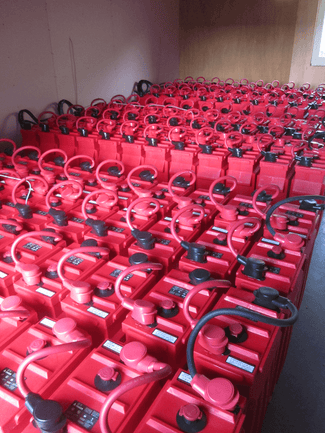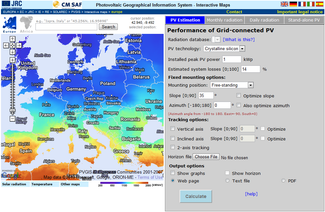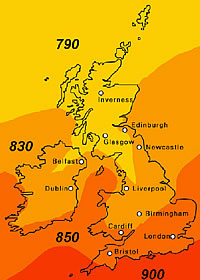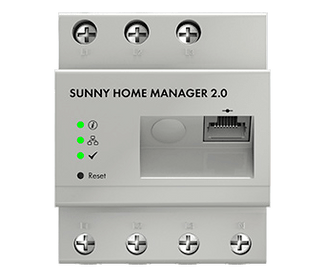Siting Solar Systems
Siting is most important: in order to get the most power, photovoltaic (PV) modules need maximum exposure to direct sunlight for the longest time. Location, inclination, orientation and shading are the main site factors that influence the performance of a PV system. Although drawings, maps or photos are a suitable means to determine inclination and orientation, an accurate estimation of any shade effects will typically require a site visit and this is the first job for anyone undertaking a PV installation.
Some other factors to consider are: ease of installation & maintenance; potential power losses due to long cable runs; location of other system components - batteries, inverter and load; and aesthetics. Some installations will also require Planning Permission.
A solar installer will be able to advise on all of this.
Geographical location
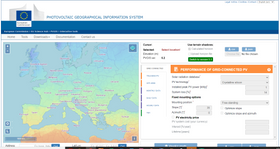
The amount of irradiance that falls onto the earth's surface alters across the UK according to several factors. The most significant factor is the location in respect of latitude (distance from the equator). Generally speaking the further the array is from the equator the less irradiation there will be; subsequently the further North the installation is the less output can be expected from a PV system. This does not preclude systems in the north as there are other factors to consider.
A useful tool for estimating monthly output using sunlight data for anywhere in Europe and Africa is available here.


Array Orientation and Inclination
To get maximum output panels should be placed so that they are perpendicular to the noon day sun, ie. due South (in the Northern Hemisphere) and at an angle of inclination approximately equal to the angle of latitude.
However, other factors can cause variation from this:
- Sites with micro-climates that have regular cloud in morning or evening or with hills, buildings or obstacles obscuring the sun at one end of the day will perform better orientated away from these.
- Existing roof pitch or orientation may determine the PV array pitch and orientation. To help ensure steady generation during the day and to better match daytime loads PV arrays orientated to both East to West can be best. (eg on buildings with E & W facing roofs).
- Steeper pitch can help in areas with high snowfall, dust or dirt to help self-cleaning (15 ° is minimum recommended pitch).
- For Off-Grid Systems a steeper angle of inclination will enhance output during winter months when the sun is lower in the sky and demand may be greatest, at the expense of some reduced output in summer.
Effect Of Orientation And Pitch on PV Performance (Percentage of Ideal Maximum)
Shade
Shade makes a big impact on the performance of a PV system - any shading will reduce module output considerably. Potential shading at different times of the day and year must be considered as even a small degree of shading on part of an array can have a very significant impact on the overall array output.
Potential shading can be much worse during winter months when the sun is lower in the sky.
Shading from objects adjacent to the array (for example: vent pipes, chimneys, and satellite dishes) can have a very significant impact on the system performance. Where such shading is apparent, either the array should be repositioned out of the shade zone, or where possible the object casting the shade should be relocated.
Shade is one element of system performance that can be specifically addressed during system design – by careful selection of array location, equipment selection and layout and in the electrical design. Where possible the array should be configured so that the shade only affects minimum number of strings at a time. Using inverters with several MPPT inputs can help with this, or if shade can't be avoided then use of optimisers is beneficial.
Inter-row shading
When a PV array consists of parallel rows of inclined panels then rows at the back can be shaded by those in front - especially in winter months.
Decreasing the pitch will allow module rows to be placed closer together and allow a bigger PV array to be fitted onto a particular site (flat roof or area of ground).
Although there will be some losses due to the inter-row shading overall annual production may be increased despite this by increasing module layout density.
Using modules with split design such as REC Twinpeak Modules and careful electrical design using inverters with multiple MPPT inputs can help alleviate this.
Planning Permission
In England and Wales there are permitted development rights for roof mounted solar PV installations, such that they are permitted unless:
- installed on any part of the external walls of the building if the building contains a flat
- panels when installed on a flat roof are situated within 1 metre from the edge of the roof or protrude more than 1 metre above the plane of the roof
- panels when installed project higher than the highest point of the roof (excluding the chimney)
- the building is within a conservation area or World Heritage Site and the solar PV or solar thermal equipment is
- installed on a roof which forms the front of the building and is visible form the road.
In Scotland, planning permission is not required for most home solar electricity systems, as long as they’re below a certain size - but you should check with your local planning officer, especially if your home is a listed building, or in a conservation area or World Heritage Site.
Mounting PV Modules
Modules may be mounted on a roof, a ground support, a pole, a wall of a building, a vehicle roof, or on a boat deck. The main considerations are day long access to unobstructed sunlight. Appearance and ease of access for any cleaning etc. should also be considered.
See: Solar PV Mounting Systems
A range of high quality kits and products are available.
PV’s work best at lower temperatures, consequently they should be installed at a distance from hot roofs etc. to allow ventilation. In roof integrated systems ventilation behind the PV array must be provided for in the roof design. In hot climates use of the higher voltage modules is preferable to offset the voltage reduction due to temperature.
Sometimes, when choosing an array mount it’s useful to leave room for a system to grow. Usually the extra cost for a frame to take extra modules will be small and then any future expansion will be straightforward.
Advantages Of Different Mounting Methods
- Rooftop Mounting: helps to avoid shadows from trees, but access for installation or srevicing can be difficult.
- South Wall Mounting: works if there is enough wall space.
- Ground Mounts: easy access & installation but take up space.
- Pole Mounts: can be easy to set up & adjust.
- Tracking Mounts: can add several extra morning & afternoon hours of full power production but moving parts will involve maintenance and can fail.
